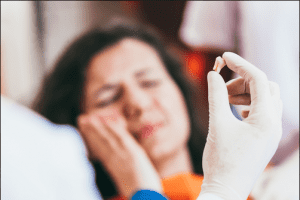Tooth Extraction treatment is never a nice procedure to experience, but you may need it if your tooth cannot be repaired.
Tooth extraction treatment is particularly necessary if your tooth is severely decayed or broken beyond repair. Naturally, the dentist enacts tooth extraction treatment as a last resort if as part of your initial examination, it’s identified the tooth cannot be saved. Tooth extraction treatment may also be necessary if you suffer from the following:
- Crowded Or Misaligned Teeth Causing An Abnormal Bite
- Forming Of Bacteria From The Decayed Teeth
- A Heightened Risk Of Infection That May Lead To Periodontal Disease
- A Broken Or Split Tooth That Cannot Be Pieced Back Together
If you’ve suffered from one of these dental concerns, it’s more likely that you’ve had tooth extraction treatment or require it.

How Tooth Extraction Treatment Is Performed?
Tooth extraction treatment may sound frightening and daunting, but the dentist makes sure your experience is as smooth, comfortable and pain-free as possible. The procedure only begins once the local anesthetic settles inside your mouth to reduce any chances of feeling any pain. The procedure then involves using strong forceps, clipped to the sides of your tooth. The forceps are then rocked back and forth slowly until the tooth becomes completely loose from its socket.
The Aftercare Recovery Treatment
Recovery from tooth extraction treatment begins as soon as the tooth is removed, and the debris is cleared from the area. A blood clot is expected once the tooth is taken out and the dentist will provide a gauze pad to bite down on to limit any bleeding.
So, the procedure is complete. Now what? What do you need to do as a patient to recover from it as quick as possible? Below are some helpful recovery tips are proven to decrease and relieve you from heavy pain.
The Five Aftercare Recovery Tips
- Take Painkillers Prescribed From Your Dentist – Prescribed medication should be taken once prescribed by your dentist. Antibiotics have proven to help limit your pain to help you adjust to the pain for the coming days. Your mouth will also reduce in swelling.
- Apply A Cold Compress To The Extracted Area – A cold compress such as an ice pack is beneficial to reduce swelling in the extracted area. Apply the cold compress to the outside cheek against the extracted area 10 minutes at a time.
- Take Plenty Of Rest And Reduce Physical Activity – One of the more frustrating things about extraction aftercare is you cannot continue with everyday life activities. You must limit any activity and take adequate rest to help speed up healing.
- Adjust Your Diet To Softer Foods – Initially, you must eat softer foods to avoid any damage to the extracted area. This may develop bacteria. Avoid solid, chewy foods for the recovery period and replace them with helpful foods such as vegetables, potatoes, soup, and water.
- Avoid Brushing Through The Extracted Area – The extracted area will be sensitive to anything that touches it, including when brushing your teeth. Brush and floss around it during the recovery phase to limit infection chances

Do you suffer from other dental emergencies? Why not learn how to prepare yourself? Click here to read more.
What We Say…
These helpful recovery tips have proven to speed up healing for many patients. Following these tips means your recovery period will reduce. These tips particularly help within the first 24 hours post-treatment.
If you’re interested in Tooth Extraction treatment or want to know more information, contact us at Wahroonga Dental Group.


